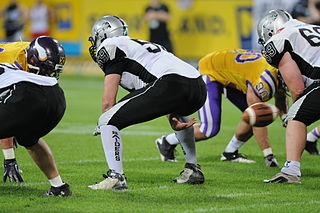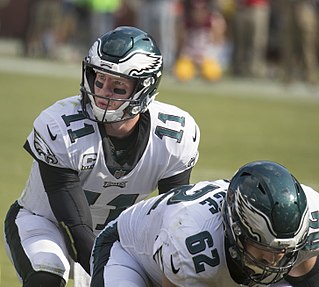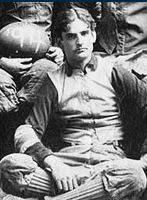
A snap is the backward passing of the ball in gridiron football at the start of play from scrimmage.

The quarterback, colloquially known as the "signal caller", is a position in gridiron football. Quarterbacks are members of the offensive platoon and mostly line up directly behind the offensive line. In modern American football, the quarterback is usually considered the leader of the offense, and is often responsible for calling the play in the huddle. The quarterback also touches the ball on almost every offensive play, and is almost always the offensive player that throws forward passes. When the QB is tackled behind the line of scrimmage, it is called a sack.
The hurry-up offense is an American football offensive style, which has two different but related forms in which the offensive team avoids delays between plays. The hurry-up, no-huddle offense (HUNH) refers to avoiding or shortening the huddle to limit or disrupt defensive strategies and flexibility. The two-minute drill is a clock-management strategy that may limit huddles but also emphasizes plays that stop the game clock. While the two-minute drill refers to parts of the game with little time remaining on the game clock, the no-huddle may be used in some form at any time. The no-huddle offense was pioneered by the Cincinnati Bengals and reached its most famous and complete usage by the Buffalo Bills, nicknamed the "K-Gun", during the 1990s under head coach Marv Levy and offensive coordinator Ted Marchibroda. Coach Gus Malzahn was known for helping popularize this offense style of combining both the hurry-up and no-huddle offenses, publishing a book called The Hurry-Up, No Huddle: An Offensive Philosophy (2003). He helped pioneer and popularize it at the high school and collegiate levels through his success with the style.

Samuel David Wyche was an American football quarterback and coach. He was a quarterback and head coach for the Cincinnati Bengals and a quarterbacks coach for the San Francisco 49ers. As head coach, he led the Bengals to Super Bowl XXIII, which they lost to the 49ers 20–16, relinquishing the lead on a last-minute touchdown. He was also known for introducing the use of the no-huddle offense as a standard offense.
Strategy is a major part of American football.
American football positions have slowly evolved over the history of the sport. From its origins in early rugby football to the modern game, the names and roles of various positions have changed greatly, some positions no longer exist, and others have been created to fill new roles.
In sports, offense or offence, known as attack outside of North America, is the action of attacking or engaging an opposing team with the objective of scoring points or goals. The term may refer to the tactics involved in offense, or a sub-team whose primary responsibility is offense.
A formation in American football refers to the position players line up in before the start of a down. There are both offensive and defensive formations and there are many formations in both categories. Sometimes, formations are referred to as packages.

Center or centre (C) is a position in American football. The center is the innermost lineman of the offensive line on a football team's offense. The center is also the player who passes the ball between his legs to the quarterback at the start of each play.
The halfback option play is an unorthodox play in American and Canadian football. It resembles a normal running play, but the running back has the option to throw a pass to another eligible receiver before crossing the line of scrimmage.

In American football, the specific role that a player takes on the field is referred to as their "position". Under the modern rules of American football, both teams are allowed 11 players on the field at one time and have "unlimited free substitutions", meaning that they may change any number of players during any "dead ball" situation. This has resulted in the development of three task-specific "platoons" of players within any single team: the offense, the defense, and "special teams". Within these three separate "platoons", various positions exist depending on the jobs that the players are doing.

The spread offense is an offensive scheme in gridiron football that typically places the quarterback in the shotgun formation, and "spreads" the defense horizontally using three-, four-, and even five-receiver sets. Used at every level of the game including professional, college, and high school programs across the US and Canada, spread offenses often employ a no-huddle approach. Some implementations of the spread also feature wide splits between the offensive linemen.

Homer Woodson "Bill" Hargiss was an American athlete and coach. He played American football and basketball and also competed in track and field events. Additionally, Hargis coached athletics in Kansas and Oregon. As an American football coach during the sport's early years, Hargis was an innovator. He was among few coaches in using the forward pass and the huddle, now staple features of the game.
The A-11 offense is an offensive scheme that has been used in some levels of amateur American football. In this offense, a loophole in the rules governing kicking formations is used to disguise which offensive players would be eligible to receive a pass for any given play. It was designed by Kurt Bryan and Steve Humphries of Piedmont High School in California.
The following terms are used in American football, both conventional and indoor. Some of these terms are also in use in Canadian football; for a list of terms unique to that code, see Glossary of Canadian football.

Wildcat formation describes a formation for the offense in football in which the ball is snapped not to the quarterback but directly to a player of another position lined up at the quarterback position. The wildcat features an unbalanced offensive line and looks to the defense like a sweep behind zone blocking. A player moves across the formation prior to the snap. However, once this player crosses the position of the running back who will receive the snap, the play develops unlike the sweep.

The Gallaudet Bison football team represents Gallaudet University in National Collegiate Athletic Association (NCAA) Division III competition. It has been discontinued many times, and most recently restarted in 2007. After an undefeated season in 2005, the first time such a season was achieved in the program's 122-year history, head coach Ed Hottle began his campaign to return Gallaudet to the NCAA ranks. With support from the Gallaudet administration, the Bison played their last season of club football in 2006 and played a full NCAA slate of eight games in 2007. In the fall of 2013, Gallaudet's football program began a remarkable run for the Division III playoffs and garnering a considerable amount of publicity, winning the regular season with a 9–1 record, before falling to Hobart College in the first round of the playoffs and ending the season with a 9–2 (.818) overall record.
A play calling system in American football is the specific language and methods used to call offensive plays.

Paul D. Hubbard (1871–1946) was a deaf American football player who is credited with inventing the modern huddle. He played football at Gallaudet University from 1892 to 1895.













